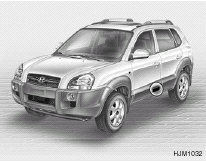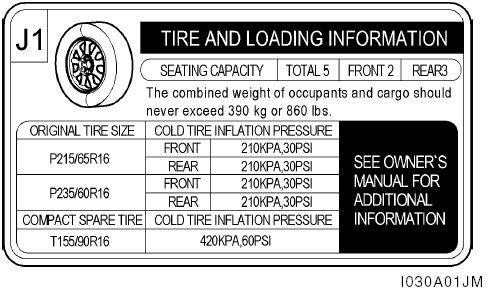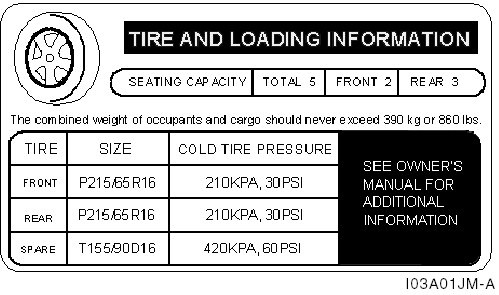Recommended cold tire inflation pressures

Tire label located on the driver's side of the center pillar outer panel gives the cold tire pressures recommended for your vehicle with the original tire size, the number of people that can be in your vehicle and vehicle capacity weight.

Type A

Type B

Type C
These pressures were chosen to provide the most satisfactory combination of ride comfort, tire wear and stability under normal conditions. Tire pressures should be checked at least monthly.
Proper tire inflation pressures should be maintained for these reasons:
WARNING:
o Inspect your tires frequently for
proper inflation as well as wear
and damage. Always use a tire
pressure gauge.
o Tires with too much or too little pressure wear unevenly causing poor handling, loss of vehicle control, and sudden tire failure leading to accidents, injuries, and even death. The recommended cold tire pressure for your vehicle can be found in this manual and on the tire label located on the driver's side of the center pillar.
o Worn tires can cause accidents.
Replace tires that are worn, show uneven wear, or are damaged.
o Remember to check the pressure of your spare tire. Hyundai recommends that you check the spare every time you check the pressure of the other tires on your vehicle.
NOTE:
o Underinflation also results in excessive
wear, poor handling and
reduced fuel economy. Wheel deformation
also is possible. Keep
your tire pressures at the proper
levels. If a tire frequently needs
refilling, have it checked by your
Hyundai Dealer.
o Overinflation produces a harsh ride, excessive wear at the center of the tire tread, and a greater possibility of damage from road hazards.
WARNING:
Overinflation or underinflation can
reduce the tire life, adversely affect
vehicle handling, and lead to sudden
tire failure. This could rusult in
loss of vehicle control and potential
injury.
CAUTION:
Always observe the following:
o Check pressures when the tires
are cold. (After the vehicle has
been parked for at least three hours
or hasn't been driven more than
one mile (1.6 km) since starting
up.)
o Check the pressure of your spare
tire each time you check the pressure
of other tires.
o Never overload your vehicle. Be especially careful about overloading if you equip your vehicle with a luggage rack.
o Worn, old tires can cause accidents.
If your tread is badly worn, or if your tires have been damaged, replace them.
See also:
A Cabin That Matches the Exterior's Promise
The Elantra's exterior sets high design expectations, but the cabin gets a
fair dose of style itself. It's stylish in numerous ways, from the simple yet
elegant ventilation system knobs to the sle ...
Washing and waxing
Washing Your Hyundai
Never wash your car when the surface is hot
from being in the sun. Always wash your car in
the shade.
Wash your car frequently. Dirt is abrasive and
can scratch the paint if ...
Seats
Driver’s seat
1. Seat forward/rearward lock release lever 2. Seatback recliner control lever
3. Seat cushion height control lever
Front passenger’s seat
4. Seat forward/rearward lock release le ...


